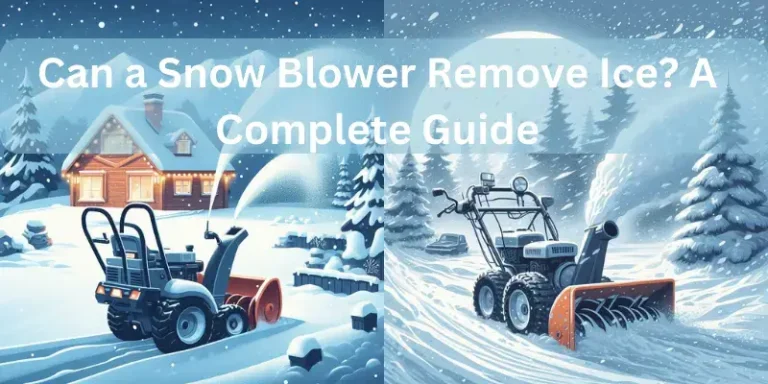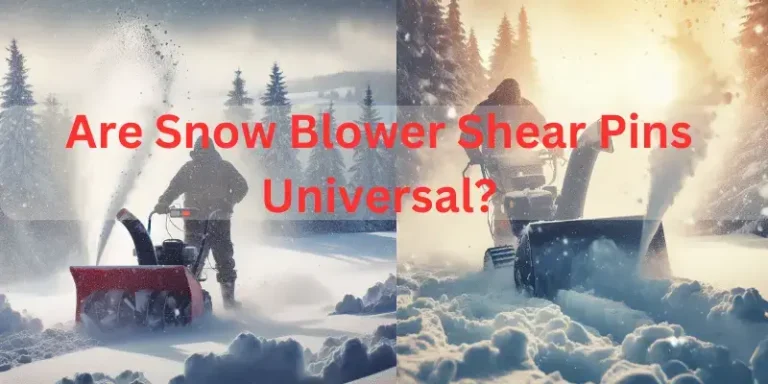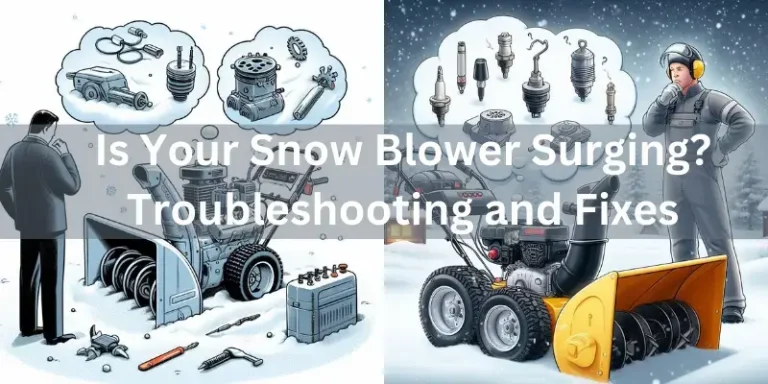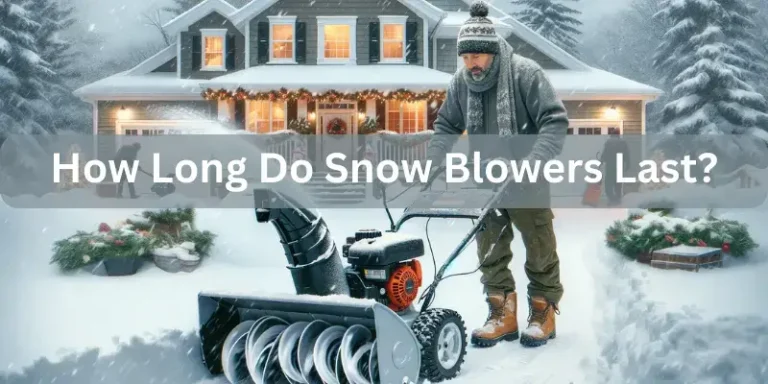How Much Snow is Needed for a Snow Blower? Understanding Optimal Conditions
Are you curious about the right amount of snow needed to effectively use a snow blower? Snow blowers are excellent tools designed to make snow removal more efficient, but understanding the minimum snow depth for their operation is vital for ensuring efficiency.
Determining the snowfall depth required for a snow blower depends on various factors. The type of snow blower, its capacity, and the conditions of the snow, especially wet snow, significantly influence its effectiveness. Different types of snow blowers, including single-stage, two-stage, and three-stage models, have varying capacities that influence their efficiency at clearing snow at different depths.
Amount of Snow: How to Measure?
Measuring Snow Depth
How much snow you have doesn’t always require fancy tools. You can use your leg as a rough gauge to estimate snow depth. For more precision, an industrial metal ruler does the job just fine. But if you frequently face snowfall, crafting a simple snow gauge can make checking snow depth a breeze, no extra tools needed.
Handling Less Than Two Inches of Snow
When dealing with less than two inches of snow, a snow blower might not be your best bet. Instead, consider a leaf blower—it’s quick to start and easy to handle for small snow amounts. Another trick involves piling the minimal snow to the side and using the blower to move it onto grass or other areas. It’s a bit more work but can significantly increase effectiveness.
Snow Blower’s Limits
Remember, a snow blower has its limits. Most can handle around 6 to 9 inches effectively, while stronger commercial models push up to 12 inches. Yet, beyond 16 inches, even the mightiest snow blowers struggle. That’s when a shovel becomes your best friend or waiting for a bit of melt before clearing is a safer bet.
Safety First
Snow removal can be tricky, especially when it’s icy. Even dry snow poses slip risks. Take your time, prioritize safety, and soon enough, that snow will be a thing of the past.
Wet Snow Vs Dry Snow: What is the Difference?
| Characteristics | Wet Snow | Dry Snow |
| Moisture Content | Higher water content, more moisture | Lower water content, drier |
| Texture | Heavy, sticky, cohesive | Light, powdery, less cohesive |
| Weight | Heavier, denser | Lighter, fluffier |
| Snowball Making | Excellent for snowballs and packing | Less suitable for packing, shaping |
| Shoveling/Removal | Shoveling/Removal More challenging, requires more effort | Easier to shovel and remove |
| Snow-based Activities | Suitable for sculpting and building | Less suitable for detailed structures |
| Ease of Transportation | Difficult to move and transport | Easier to move and clear |
Understanding these differences is essential for choosing the appropriate tools and techniques for snow removal and engaging in snow-related activities based on the type of snow encountered.
Understanding the Minimum Snow Depth
Minimum Snow Depth refers to the least amount of snow needed for a snowblower to work well and do its job properly. Using a snow blower for light dusting can be overkill and might not be efficient or even possible, depending on the machine.
Why Minimum Snow Depth Matters
The effectiveness of your snow blower isn’t just about its power or size; it’s also about using it under the right conditions. Here’s why the depth of snow is a game-changer:
- Prevents Damage: Running your machine on too little snow can lead to wear and tear, as the blower might pick up and throw rocks or debris instead of snow.
- Energy and Time Efficient: You save time and energy (yours and the blower’s) by using it when it can perform at its best, which is not on a mere sprinkle of snow.
- Safety First: It’s safer to use the equipment as intended. Incorrect usage can lead to accidents or damage.
How much snow can a snow blower handle?
Single-Stage Snow Blowers:
Single-stage snow blowers are best suited for light snow falls ranging from 3 to 6 inches in depth, while two inches of snow might be too little for these machines. Their efficient augers work effectively to clear snow in these lighter accumulations without overexertion, making them ideal for smaller residential areas.
However, single-stage blowers might struggle to remove the snow from heavier loads, reducing their efficiency and potentially causing strain on the machine. It is important to understand their limitations in dealing with 12 inches of snow and avoid pushing them beyond their recommended capacities.
Two-Stage Snow Blowers:
Two-stage snow blowers, with their enhanced power and capacity, excel in handling snow depths ranging between 6 to 12 inches. Their auger and impeller combination can clear snow from these moderate accumulations with ease, making them suitable for larger properties.
These blowers are more adept at handling heavier loads, allowing for more efficient and quicker snow removal. However, pushing them beyond their limits might affect their performance, leading to potential clogging or decreased efficiency when attempting to clear 12 inches of snow or more.
Three-Stage Snow Blowers:
Three-stage snow blowers, designed for heavy-duty tasks, are equipped to handle snow depths exceeding 12 inches. Their powerful auger and impeller systems can efficiently clear significant snow accumulations from the surface, making them ideal for heavy snowfall regions or commercial use.
These robust machines can handle heavy snow loads efficiently, ensuring effective snow removal, even when clearing 12 inches of snow or more in the most extreme conditions. However, regular maintenance and understanding their operational limitations, especially when dealing with wet snow.
How to Use a Snow Blower Effectively: Maximizing Performance
To make the most of your snow blower:
Clear in Passes
Work in overlapping paths, avoiding overly thick layers of snow with each pass to prevent overburdening the machine.
Adjust Speed and Direction
Control the blower’s speed and direction based on the snow density and terrain for optimal efficiency.
Mindful Technique
Be mindful of your technique, avoiding sudden or forceful movements that might strain the machine or disrupt its function.
How to maintain a snow blower?
Regular maintenance is key to keeping your snow blower in top shape:
Pre-Season Check
Before the snow season begins, it’s essential to conduct a comprehensive pre-season check-up on your snow blower. This check ensures that your equipment is in optimal condition for the impending snowfall. Here’s a detailed breakdown of the steps involved:
Inspect Spark Plugs
Start by examining the spark plugs. Look for any signs of wear, corrosion, or damage. Replace them if needed to ensure a smooth start and efficient engine performance during snow clearing.
Check Belts and Cables
Evaluate the condition of the belts and cables. Look for fraying, cracks, or signs of excessive wear. Taut and properly functioning belts and cables are essential for the snow blower’s operational efficiency.
Lubricate Moving Parts
Lubrication is key to preventing friction and ensuring smooth operation. Apply lubricant to the moving parts, such as the auger and chute, to facilitate their movement and reduce wear and tear.
Examine Fuel System
Check the fuel system for any residual fuel from the previous season. Stale fuel can impact engine performance. Consider draining old fuel and replacing it with fresh, high-quality gasoline.
Inspect Controls and Safety Features
Verify that all controls and safety features, such as the safety keys and shut-off switches, are functional. These safety mechanisms are mandatory for your protection during operation.
Test Run
Finally, before the snowfall arrives, start the snow blower for a test run. Ensure that it starts smoothly and runs properly. This test run allows you to address any potential issues beforehand.
By performing this comprehensive pre-season check-up, you’re ensuring that your snow blower is in top-notch condition, ready to tackle the snow and make your winter snow-clearing tasks efficient and hassle-free
Clearing and Cleaning
Clearing and cleaning your snow blower after every use is mandatory to maintain its efficiency and prolong its lifespan. Here’s a more detailed breakdown of the steps involved in this process:
Removing Snow Residue
Begin by clearing any remaining snow from the snow blower’s auger, chute, and other parts. Use a brush or a shovel to gently remove snow build-up. Ensure that the machine is turned off and the spark plug is disconnected for safety.
Clearing Debris
Check for any debris, such as twigs, leaves, or stones, that might have accumulated during use. Clear these obstructions to prevent clogs or damage to the machine’s components.
Inspecting Auger and Chute
Examine the auger and chute for any remaining snow or ice. Use a tool or your hands to clear any ice build-up or packed snow, ensuring these parts are free from blockages.
Cleaning Surfaces
Wipe down the exterior surfaces of the snow blower to remove any remaining snow or moisture. Dry the machine thoroughly to prevent rust or corrosion.
Storage Preparation
If you’re done using the snow blower for the season, prepare it for storage by ensuring it’s completely clean and dry. Consider applying a rust inhibitor or protective coating to susceptible parts to prevent corrosion during storage.
Regularly clearing snow residue and debris after each use ensures that your snow blower remains in top working condition, ready for the next snow-clearing task. It also minimizes the risk of clogs, damage, or corrosion, extending the lifespan of your equipment.
Oil and Fuel Care
Oil and fuel care is very important for snow blowers, because when there is snow everywhere, it is very hard to go anywhere to buy oil and call any repair technician so you face trouble. To avoid any mishap, you can check following oil and fuel related issues in your snow blower for addressing on time:
Regular Oil Changes:
Follow the manufacturer’s guidelines for regular oil changes. Changing the oil at recommended intervals ensures the engine operates smoothly and efficiently. Drain the old oil completely, replace the oil filter if applicable, and refill with the recommended oil type and quantity.
Fuel System Maintenance:
Consider using high-quality fuel and adding a fuel stabilizer if the snow blower will be stored for an extended period. Stale fuel can affect engine performance. Also, periodically check and replace fuel filters based on the manufacturer’s recommendations to ensure a clean fuel supply.
Oil Filter Replacement:
If your snow blower is equipped with an oil filter, replace it at the recommended intervals or during oil changes. A clean filter helps maintain oil quality and protects the engine from contaminants.
Checking Oil Levels:
Routinely check oil levels using the dipstick and ensure they are within the recommended range. Adjust oil levels as needed to prevent engine damage due to inadequate lubrication.
Following Manufacturer’s Guidelines:
Always adhere to the manufacturer’s specifications and recommendations regarding oil type, oil change intervals, fuel type, and filter replacements for optimal performance and life of your snow blower.
How to store a snow blower?
Storage of snow blowers is very important for their efficient work. These equipment are only use in winters so if you not store it in proper place you may face serious repercussions when you start blowing snow in the winter.
Thorough Cleaning:
Before storage, ensure the machine is meticulously cleaned. Remove any remnants of snow or debris. Allowing it to dry completely before storage helps prevent rust formation, maintaining its integrity.
Fuel Consideration:
Prior to storing, address excess fuel. Either drain the fuel tank or add a fuel stabilizer to prevent potential damage or degradation during the storage period. Proper fuel management safeguards the engine.
Protective Covering:
Choose a dry and sheltered storage location for the snow blower. Shield it from moisture and dust by covering it adequately. This protective covering safeguards against environmental elements, preserving its condition.
By adhering to these steps, you safeguard your snow blower during its idle period, ensuring it’s in optimal condition when you’re ready to use it again.
Is a snow blower effective at removing slush?
A snow blower can handle slush to some extent, but its effectiveness can be limited compared to removing dry or powdery snow. Slush, being a mix of snow and water, tends to be heavier and more dense. This heaviness can make it challenging for a snow blower to efficiently clear as it might clog the machine or reduce its throwing distance.
Single-stage snow blowers might struggle more with slush due to their design, while two-stage or three-stage blowers might handle it slightly better because of their enhanced power and auger design. However, even with more powerful blowers, slushy snow can still pose challenges.
Tips to enhance snow blower effectiveness with slush:
- Adjust the height setting to avoid collecting excess water.
- Clear slush more frequently to prevent buildup.
- Manual shoveling or specialized equipment might be more effective for heavy, wet slush.
FREQUENTLY ASK QUESTIONS (FAQs)
Bottom Line
In summary, knowing the ideal snow depth for your snow blower streamlines the snow removal process, making winter tasks more manageable and efficient. This knowledge not only facilitates smoother operations but also plays a pivotal role in preserving the durability of your equipment.
Additionally, adhering to regular maintenance routines, employing effective usage techniques, and implementing proper storage practices are vital pillars that contribute significantly to the efficiency and performance of your snow blower.
By incorporating these elements into your snow blower care regimen, you ensure not just effective snow removal but also maximize the lifespan and reliability of your equipment, guaranteeing a more seamless winter season year after year.

About Naveed A Hashmi
In my childhood, I used to see my parents while working in the land, for these reasons today I have been serving the same as our own tradition and culture. I thus love to stay in it, because I want to learn something advanced and new so that I may improve my farm’s contour and help others with my experience.







